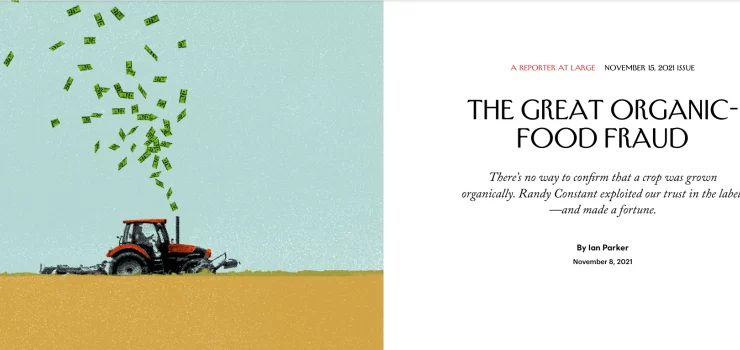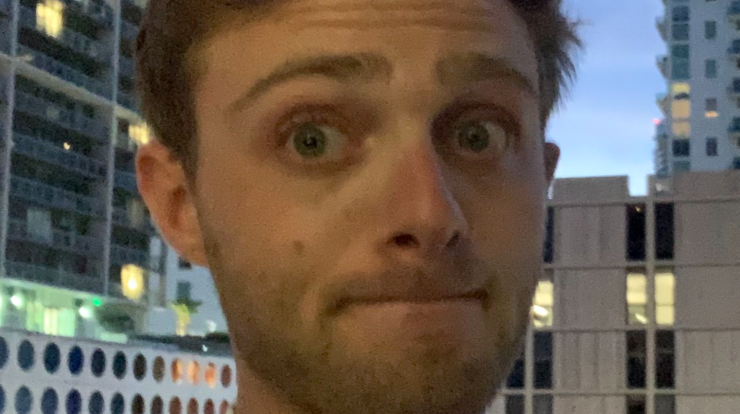
Glen Borgerding met Randy Constant in the late nineteen-nineties, when landowners in northern Missouri hired them to help set up an organic soybean farm. Borgerding, an agronomist from Minnesota, took soil samples and made recommendations about fertilizer and weed control; Constant, a Missouri native who had a day job as a regional sales manager for the Pfister seed company, ran the farm’s day-to-day operations. By then, Borgerding had spent more than a decade in organic agriculture. Constant had not, but he had evident ambition. Borgerding recently told me, “Randy was an exciting guy to be around—when things were working well.”
Constant, then in his thirties, had a degree in agricultural economics from the University of Missouri. Since graduating, he had “worked his way up the agricultural corporate ladder,” as his wife, Pam, later put it. In the eighties, a time of collapse in America’s farming economy, he had taken a series of sales and managerial jobs across the Midwest, before returning with Pam and their three children to live in Chillicothe, Missouri—a town of about nine thousand residents, ninety miles northeast of Kansas City, where he and Pam had grown up. Constant became active in Chillicothe’s United Methodist church, and later served as president of the town’s school board.
Constant appeared to be “the epitome of the Midwestern guy,” Ty Dick, a former employee, said recently. “Straightforward, healthy, wholesome.” Constant wore button-down shirts; his hair was always neatly combed. Hector Sanchez, who once worked for Constant in Chillicothe, recalls his former boss’s solicitousness: “He always asked me, ‘Do you need anything? Are you good ?’ ” When Constant met Borgerding, he had recently become licensed to sell real estate, and he occasionally sold a farm on behalf of Rick Barnes, of Barnes Realty, in Mound City, Missouri. Barnes, who told me he used to think that Constant missed his calling by not selling real estate full time, said, “He came across like a deacon in the church. He probably was a deacon.”
After the soybean-farm collaboration ended, Borgerding and Constant discussed starting a business together. “I had a lot of trust in him,” Borgerding said. “I felt that he had a lot of integrity. I felt that we had a very unified vision of what we wanted to accomplish.” In 2001, they founded a company, Organic Land Management.
John Heinecke lives and farms near Paris, Missouri, a hundred miles east of Chillicothe. When I called him to ask about Constant, he said, “That cocksucker. He screwed me over to fucking death.” Heinecke was about to drive to his weekend house, on an inlet at the Lake of the Ozarks, and he agreed to meet me there a few days later.
We spoke on his screened-in porch, which had a view down to his dock and his motorboat. Heinecke, who is in his early sixties, was wearing a sleeveless T-shirt and a fentanyl patch; he talked of spinal injuries related to a lifetime of agricultural lifting. Now and then, we had to shout over the straight-pipe speedboats screaming down the lake’s main channel.
Heinecke first went bust in the mid-eighties, when he was farming rented land. “Bank called my notes,” he said. By the time he met Constant, in the mid-nineties, he was enjoying a period of success as a contract farmer, working fifteen hundred acres for various owners. “I probably had forty farms or so,” he said. “A lot of little farms. I was a patch king!”
Heinecke used to have a sign at the end of his driveway which read “i shoot every third salesman.” Constant, pitching for Pfister, came to the door. Heinecke remembered him as “a smooth talker, one of these guys you have to worry about.” Constant enlisted Heinecke to become a local seed salesman for Pfister. That was their business relationship for the next few years. Then, around 2000, Constant asked if Heinecke knew of any pastureland that wasn’t being used. Heinecke mentioned a nine-hundred-acre farm, owned by a relative, a section of which hadn’t been tilled in years. “Can you rent that?” Constant asked. He then explained that he wanted to farm it organically.
Heinecke recalls replying, “Tell me what this organic deal is.”
More than in most retail transactions, the organic consumer is buying both a thing and an assurance about a thing. Organic crops are those which, among other restrictions, have been grown without the application of certain herbicides, pesticides, and fertilizers. Close scrutiny of a crop of non-organic tomatoes might reveal that they had been exposed to these treatments. But it might not. And an organic product can become accidentally tainted if proscribed chemicals carry across from a neighboring crop. The rules forgive such contamination—to a point. Testing for residues is not common in American organic regulation.
The real difference, then, between a ton of organic soybeans and a ton of conventional soybeans is the story you can tell about them. The test, at the point of sale, is merely a question: Was this grown organically? That’s not like asking if a cup of coffee is decaffeinated. It’s more like buying sports memorabilia—is this really the ball?—or like trying to establish if a used car has had more than a single, careful owner.
The organic story has legitimate power. A farm’s conversion to organic methods is likely to increase biodiversity, reduce energy consumption, and improve the health of farmworkers and livestock. And, to the extent that agricultural chemicals enter the food supply, an organic diet may well be healthier than a conventional one.
When Constant asked Heinecke about pastureland, American organic agriculture had just begun booming. In 2000, organic sales in ordinary supermarkets exceeded, for the first time, sales in patchouli-scented health-food stores. During the next five years, domestic sales of organic food nearly doubled, to $13.8 billion annually. The figure is now around sixty billion dollars, and the industry is defined as much by large industrial dairy farms, and by frozen organic lasagna, as it is by the environmentalism and the irregularly shaped vegetables of the organic movement’s pioneers.
A new national system of organic certification, fully implemented in 2002, helped spur this growth. Previous regulation, where it had existed, had been uneven: farmers in Iowa could become organic by signing an affidavit saying that they farmed organically. Given the inscrutability of a crop’s organic status, the new system was likely to preserve an element of oath-making, but the reliance on trust was now overlaid—and, perhaps, disguised—by paperwork. Organic farmers, and others in the organic-food supply chain, were now required to hire the services of an independent certifying organization—one that had been accredited by an office of the U.S. Department of Agriculture, the National Organic Program. A certifier kept an eye on a farm’s operation, primarily through an annual scheduled inspection.
Among the new federal rules: land subjected to non-organic treatments couldn’t be converted to organic production overnight. The process would take three years. Given how fast the organic market was expanding—including for meat, eggs, and dairy products, derived from animals given only organic feed—land that needed no transition period became valuable.
Organic Land Management proposed to find such land and, in exchange for a share of a farmer’s profits, get it certified, and then help grow and market the crops. “At the time, conventional corn was, let’s say, two dollars a bushel,” Borgerding told me. “The first corn crops that we sold were three-seventy-five and four dollars a bushel.”
Constant and Borgerding never worked out of the same office. Borgerding made deals with farmers in Minnesota and the Dakotas; Constant kept farther south. Their company’s pitch was bound to appeal to farmers who had bad credit, or other problems. John Heinecke, the patch king who’d struggled with bankruptcy, agreed to join. In Overton, Nebraska, Constant also signed up James Brennan and his father, Tom—a decorated Vietnam veteran whose alcohol abuse, connected to P.T.S.D., would lead to several convictions for drunk driving.
Within a few years, Organic Land Management was handling six thousand acres, on a dozen farms in five states. In the eyes of American regulators, this was a single operation, requiring only a single organic certification—as if the company’s scattered fields were divided only by railroads or rivers, rather than by, say, Iowa.
Constant and Borgerding settled on Quality Assurance International, based in San Diego, as their certifier. This was not the cheapest option. Q.A.I.’s core business was certifying food-processing companies, not farms; its name is now on every other box of American organic cookies and cornflakes. I recently spoke with Chris Barnier, who, between 2004 and 2007, oversaw Organic Land Management’s finances and records. Though he did not directly criticize Q.A.I., he said, “It’s a huge flaw in the organic industry that the farmers pay the certifier—sometimes many thousands of dollars. The certifier has a conflict of interest, because they really don’t want to blow the whistle on a fraud.”
Moreover, any inspection, however principled the investigator, is likely to be cursory. After Barnier left Organic Land Management, he worked for a while as an inspector himself. He explained that extending a farm visit beyond a couple of hours—looking at paperwork, asking questions—can feel like a provocation. The cows need milking, the kids are whining. An established grain trader recently told me that the certification industry is essentially toothless, adding, “If you saw my operation, then came and saw what they do on an inspection, your mind would be blown. I do thousands of transactions a year. They look at three.”
Borgerding told me, “Chris and I worked real hard to maintain the integrity of things—to make sure all of our organic paperwork was in order.” Nevertheless, he acknowledged that he had been drawn to Q.A.I. partly because the company was perceived not to nitpick: “It was not my intention to abuse their potential leniency. But I think they kind of glossed over things.” And, because Q.A.I. inspectors were not farm specialists, “they—at least at that time—were a little bit unaware. It was just more of a foreign territory to them.” He added, “They’re way out in California! What did they know about Midwest agriculture?” (A representative for Q.A.I. said that its inspectors understand the “intricacies of their particular region’s agricultural industry.”)
Constant and Borgerding were able to pay themselves a hundred thousand dollars a year. The Constants, who had a son and two daughters, the youngest of whom was in her teens, moved into a spacious house on Oaklawn Drive, in Chillicothe’s more monied end. Their furnishings included ceramic rabbits, two crosses, and a framed map of Hilton Head Island, South Carolina, where the family liked to vacation.
Looking back, Borgerding can see that he failed to notice warning signs about his partner. He said that, in Missouri, he “would mention Randy’s name and people would just close down, back off.” He knew that Constant always had a side project. “When I hooked up with him, I was the side project,” he said, referring to Constant’s job at Pfister. “But it always haunted me a little: What happens when our business becomes the main project? What would Randy do on the side?”
He recalled once watching in awe as Constant deflected an agricultural inspector’s query about record-keeping. In a flurry of paper, “Randy threw down this document, tied to this document, and tied to this document, and presented it as ‘It’s so obvious, any idiot can figure this out—why can’t you?’ ” The inspector retreated. Today, Borgerding has a sense that he witnessed a charade. But, he said, “the tone in Randy’s voice, and the way he acted, it was like Novocaine—it just put you at ease.”
In 2001, Constant, on behalf of Organic Land Management, signed a contract to deliver organic soybeans from farmers it worked with to a facility in Beardstown, Illinois, owned by the Clarkson Grain Company. Clarkson, which buys grain from farmers and sells largely to food manufacturers, was an early specialist in organic grain and in grain that is not a genetically modified organism, or a G.M.O. The grain industry was then being transformed by such new products as Monsanto’s Roundup Ready soybeans and corn, which are genetically modified to survive in fields sprayed with Roundup, a weed killer made by the company.
A non-G.M.O. crop might or might not be organic, but a genetically modified crop is definitely not organic. Today, it’s nearly inevitable that a commercial buyer of organic grain will subject the crop to a G.M.O. test, which can take only a few minutes. But in 2001 it was unusual for such buyers to test every delivery. Clarkson did.






